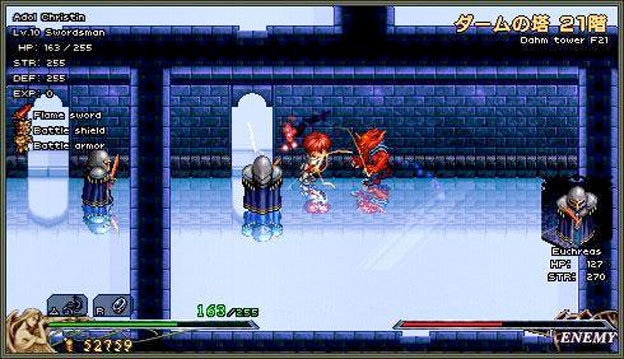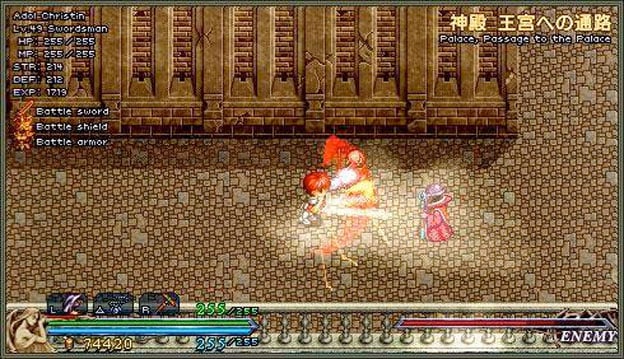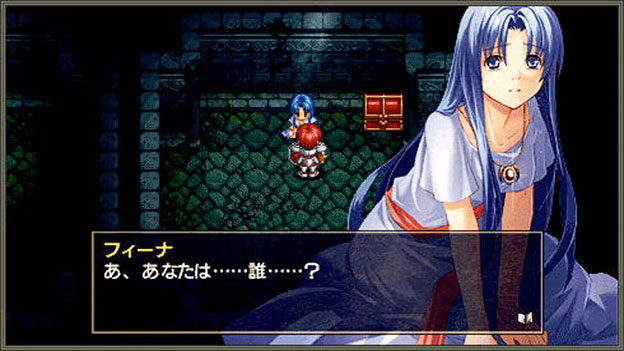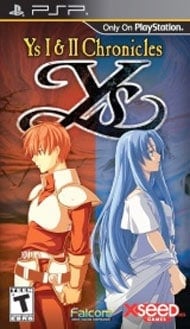Rock ‘Em, Sock ‘Em Swordfighting
Nihon Falcom, a Japanese developer, isn’t well-known in North America, but localization and publishing company XSEED Games hopes to change that. XSEED is currently publishing games from two major Falcom series, the epic RPG series Legend of Heroes and the action RPG series Ys (pronounced “Yees.”) Ys I & II Chronicles takes gamers to the beginning of the Ys series, introducing us to the courageous wandering flame-haired swordsman, Adol Christin. The two games basically tell a single story, with Ys II beginning immediately after the end of Ys I.

Ys I begins with Adol shipwrecked on a small island kingdom that has been isolated from the rest of the world by a mysterious “stormwall.” There’s the matter of a rampaging demon army to take care of, and Adol sets off to defeat the demons on a journey that will lead him to the mysterious Land of Ys in Ys II. The story is told in snippets, with just enough (and sometimes not enough) information to drive the player forward to the next goal. Fortunately, XSEED has done its usual solid localization job, allowing the personalities of the various colorful characters populating the world to shine through without going over the top with wackiness or Western cultural references. Although the player never spends much time with the secondary characters in the world of Ys, many of them are interesting and memorable, not to mention carefully cataloged in the game’s “notes” menu.
Ys I and II Chronicles looks rather nice for a remake of two games that came out about twenty years ago. Still character portraits and backgrounds feature lovely, anime-style artwork. The towns, character sprites, and monsters are very crisp considering their small size, and some of the boss designs are appropriately grotesque. The wilderness and dungeon tilesets aren’t anything special, but they set the mood for the areas they’re depicting. Unfortunately, they’re also quite repetitive within areas, which doesn’t help when a player gets lost in the sprawling dungeons.

The sound design of the games is a standout, particularly for fans of 1980’s metal music. There are three soundtracks to choose from, but the version created especially for this port by Falcom’s in-house rock band is the highest quality and the most fun to listen to. It’s worth wearing headphones while playing the game, particularly for the metal tracks that play in the game’s combat-oriented areas. They contrast nicely with the haunting pieces that play during slower parts of the game, and add a sense of dynamism to the adventure. The sound effects in battle do what they should, providing satisfying collision sounds when Adol slams into an enemy. There is no voice acting in Ys I and II Chronicles, but considering the large cast of characters with only small amounts of dialogue amongst them, voice acting doesn’t feel necessary.
As it’s an action RPG, the heart of Ys I & II Chronicles is the battle system, which is refreshingly different from the norm. In order to damage enemies with his sword, Adol simply needs to slam into them, no button presses involved. If he hits them head-on, he takes damage, but if he hits them from the back, sides, or at an angle, he does damage. The enemies do their best to attack Adol head-on, so it can be challenging not to take damage. It’s important to learn to kill enemies without taking damage, because the player’s health will not regenerate in dungeons without an HP-regen item equipped, and HP recovery items are in short supply. Fortunately, with practice the player will become adept at the combat system, and there is a simple joy to be found in plowing sideways into hordes of demons. There are also several difficulty levels to choose from, assisting both reflex-impaired gamers and those seeking a hard-core challenge.

The boss battles in Ys are several orders of magnitude more difficult than ordinary fights, relying on learning patterns and finding openings in order to damage the boss without getting hurt. With the limited supply of health-regenerating items, many players will find themselves having to try a boss several times before successfully beating it. It’s usually a good challenge though, feeling winnable as long as the player is leveled up enough and has the correct tools needed for the fight. Luckily, the game allows one to save anywhere, and the presence of a boss in the next room is telegraphed by unique doors, so it’s easy to save right before engaging a boss.
Ys II adds a new dimension to the battle system by giving the player a fire spell, which is frequently the only way to damage bosses. Although fans of button-pressing may welcome the fire spell, I found the boss battles in Ys II to be less interesting because of it. They felt more like the battles in any number of retro action RPGs, where the player simply memorizes patterns and presses a button to cast a spell when there’s an opening. I preferred the boss battles in Ys I, in which Adol had to find ways to slam into the bosses without getting hurt. They were fresher and less drawn-out than the battles in Ys II.
Unfortunately, despite the fun battle system, it won’t take gamers long to be reminded that Ys I & II Chronicles is a port of two very old games. As the player progresses through Ys I, there will be less direction as to where to go next. At first, it’s not too difficult to run around and talk to townspeople in order to get a clue to the next plot step, but later on there are required plot steps that are frustratingly oblique. The whole thing culminates in an incredibly annoying backtracking session right before the final boss. After ascending twenty levels in a massive tower, the player is suddenly stymied in front of a door that will not open. The game provides no clue as to why the door is sealed or how to open it. What the player must do is climb back down the tower for eleven levels to retrieve an amulet from an NPC, then climb back up to the top, where the door will finally open. It’s an unavoidable, pointless slog, made worse by the game’s complete lack of direction as to where to go.

Ys II provides the player with clearer plot direction, but suffers from its own retro-related problem. Neither game has any mapping system whatsoever, but the dungeons and wilderness areas in Ys II suffer particularly from being “a maze of twisty little passages, all alike.” Without a map, it’s very easy to get lost in the dungeons, and even veteran gamers who might be willing to whip out the graph paper will find it difficult to map the dungeons’ multidimensional twists and turns.
Still, there’s fun to be had in the exploration and puzzle-solving segments of Ys I & II Chronicles. Even if the game doesn’t give enough direction sometimes, it’s nice to have to explore, talk to NPCs, and actually think instead of mindlessly wandering to the next NPC with a freaking yellow exclamation point over its head. Ys II in particular has some neat little touches, such as being able to turn into a cute little demon and talk to the same enemies that Adol would be plowing through in his human form. It’s simply too bad that so many of the game’s puzzles involve backtracking through the twisty dungeons in order to find the correct items in the correct order needed to proceed.
Unless the player spends large amounts of time wandering around, lost and/or clueless, both games can be completed quickly. Ys I is particularly short, spanning only a few dungeons and between five and eight hours. Ys II is larger and could take between eight and twelve hours. There are multiple difficulty levels and a time attack mode available for players who really love the game, but I suspect that most gamers will complete Ys II, say “OK, that was pretty fun,” and never pick it up again. There isn’t anything in the way of hidden secrets to inspire multiple playthroughs, and although the battle system is fun, there’s only so much that can be done with it. It’s the kind of experience that works best in short bursts.
Ys I & II Chronicles is worth a look by action RPG fans for the battle system alone, which is unlike any other and can be a real blast. Patient, retro-oriented gamers will gleefully endure the game’s old-school relics, while others may want to play with some maps and a FAQ in hand. Anybody looking for a modern-style action RPG experience would be advised to give Ys I & II Chronicles a pass, and consider checking out the series via Ys 7.
RATING OUT OF 5 RATING DESCRIPTION 3.5 Graphics
While not breathtaking, the graphics are sharp and attractive, particularly the sprites and the still artwork. 3.9 Control
The movement/battle controls can be freely changed between fast and loose or slow and precise, and with the exception of some boss fights, the battles are fast and fun. 4.0 Music / Sound FX / Voice Acting
The lively, high-quality soundtrack is worth listening to on headphones. It’s at its best in the game’s battle areas, where metal remixes of the original game’s themes drive the player forward into battle. 2.9 Play Value
While the battle system is addictive and a time attack mode can extend gameplay, many gamers will be frustrated by retro relics such as the lack of a map for the sprawling dungeons and frequent backtracking. 3.3 Overall Rating – Good
Not an average. See Rating legend below for a final score breakdown.
| Review Rating Legend | |||
|---|---|---|---|
| 0.1 – 1.9 = Avoid | 2.5 – 2.9 = Average | 3.5 – 3.9 = Good | 4.5 – 4.9 = Must Buy |
| 2.0 – 2.4 = Poor | 3.0 – 3.4 = Fair | 4.0 – 4.4 = Great | 5.0 = The Best |
Game Features:
